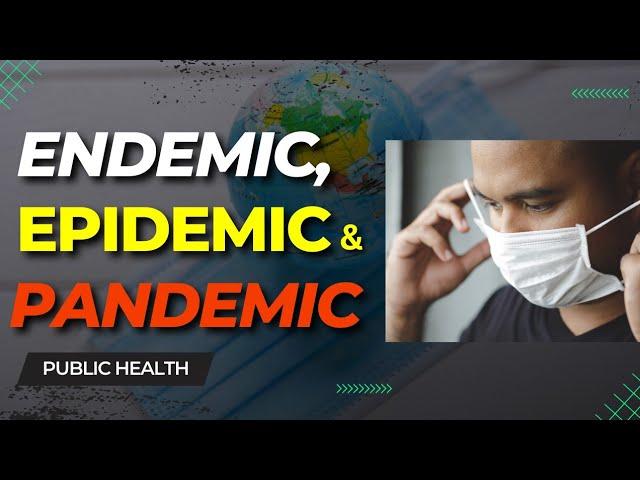
Endemic, Epidemic and Pandemic Difference Explained | Public Health 101
Hello and welcome to this video where we are going to be learning about Endemics, Epidemics, and Pandemics.
Infectious diseases are spread by either bacterial or viral agents and are ever-present in society. Usually, infected cases are present in numbers below an expected threshold but every once in a while, there may be an outbreak, a new strain or a new disease that has a significant impact at either a local or global level. The spread and rate of new cases can be classified as:
Endemic Epidemic and Pandemic difference.
Firstly, let’s talk about:
Endemic.
An endemic disease is a disease that is present permanently in a region or population. The term endemic is used to describe a disease that is present at an approximately constant level within a society or country.
Each country may have a disease that is unique and also present in the population, for example, Malaria is an infectious disease that is endemic to Africa.
Now let talk about Epidemics;
Epidemic is used to describe a situation where a disease spreads rapidly to a large number of people in a given population over a short time period.
The term epidemic is not only used with infectious diseases. It is also used with any scenario that leads to a detrimental rise of health risks within a society. For example;
• The rise in obesity globally (often described as an "obesity epidemic").
Over the last 3 decades, the United States has seen an increase in the number of people W H O have a BMI higher than the recommended average.
When the term epidemic is used in connection with infectious diseases it is due to the sudden rise of cases usually resulting from a new infectious agent or a change in an existing agent, for example:
• new strains of the Covid virus in a particular country,
Epidemics can follow predictable patterns and these trends are often used to monitor, predict, and control the spread of the infection. A typical example of this is seasonal flu.
However, in the case of a pandemic;
Pandemic is the term used to describe the rapid spread of a transmissible infectious or communicable disease over several continents or worldwide.
Once an epidemic becomes global and affects a large percent of the population it becomes known as a pandemic.
The terms pandemic and epidemic are used to describe the rate and distance of the spread of the disease and not the severity of the disease.
Significant features of a pandemic are as follows:
• Affects a wider geographical area, often global
• Infects a very large number of people
• Often caused by a new virus or a new strain of a virus that has been dormant for many years.
• Spreads quickly in humans as there is little to no existing immunity;
• Can cause a high number of deaths;
• Because of the need to control the spread of the disease, there is often social disruption, unrest and economic loss.
The World Health Organization (W H O) will declare a Pandemic when a disease has shown exponential growth - dramatically increasing rate of growth, each day showing many more cases than the previous day. A current example of this is the Coronavirus Disease (COVID-19). On 31 December 2019, a cluster of cases of pneumonia of unknown cause, in the city of Wuhan, Hubei province in China, was reported to the W H O.
Stages of a Pandemic:
The W H O has identified six phases that it follows before declaring a pandemic. Phase 1 represents a low risk and phase 6 is a full-blown pandemic, you can see the phases below:
• Phase 1 - a virus is seen in animals but has not been shown to infections in humans.
• Phase 2 - a known animal virus has caused an infection in humans.
• Phase 3 - scattered or isolated incidence of cases or small clusters of the disease occurring in humans; possible cases of human-to-human transmission but not at a level to cause community-level outbreaks.
• Phase 4 - human to human transmission at a rate that causes an outbreak in communities.
• Phase 5 - the spread of the disease between humans is now evident in more than one country.
• Phase 6 - community-level outbreaks are in at least one additional country other than that seen in phase 5.
Once Phase 6 is reached preparation is then made for a global pandemic. Each phase has a list of actions that need to be followed to facilitate transparency and the education of health organizations and members of the public.
VIDEO KEY WORDS ARE:
ENDEMIC EPIDEMIC AND PANDEMIC DIFFERENCE, ENDEMIC EPIDEMIC PANDEMIC, ENDEMIC EPIDEMIC AND PANDEMIC, ENDEMIC, EPIDEMIC, PANDEMIC, ENDEMIC DISEASE, ENDEMIC EPIDEMIC, ENDEMIC PANDEMIC, EPIDEMIC ENDEMIC AND ERADICATION, PANDEMIC AND EPIDEMIC DIFFERENCE, PANDEMIC COVID 19, PANDEMIC EPIDEMIC ENDEMIC DIFFERENCE, PANDEMIC NEWS, PANDEMIC QUARANTINE, EPIDEMIC TO PANDEMIC, EPIDEMIC DEFINITION, EPIDEMIC DISEASE, EPIDEMIC IN COMMUNITY MEDICINE, EPIDEMIC OUTBREAK, EPIDEMIC VS PANDEMIC, HEALTH
Infectious diseases are spread by either bacterial or viral agents and are ever-present in society. Usually, infected cases are present in numbers below an expected threshold but every once in a while, there may be an outbreak, a new strain or a new disease that has a significant impact at either a local or global level. The spread and rate of new cases can be classified as:
Endemic Epidemic and Pandemic difference.
Firstly, let’s talk about:
Endemic.
An endemic disease is a disease that is present permanently in a region or population. The term endemic is used to describe a disease that is present at an approximately constant level within a society or country.
Each country may have a disease that is unique and also present in the population, for example, Malaria is an infectious disease that is endemic to Africa.
Now let talk about Epidemics;
Epidemic is used to describe a situation where a disease spreads rapidly to a large number of people in a given population over a short time period.
The term epidemic is not only used with infectious diseases. It is also used with any scenario that leads to a detrimental rise of health risks within a society. For example;
• The rise in obesity globally (often described as an "obesity epidemic").
Over the last 3 decades, the United States has seen an increase in the number of people W H O have a BMI higher than the recommended average.
When the term epidemic is used in connection with infectious diseases it is due to the sudden rise of cases usually resulting from a new infectious agent or a change in an existing agent, for example:
• new strains of the Covid virus in a particular country,
Epidemics can follow predictable patterns and these trends are often used to monitor, predict, and control the spread of the infection. A typical example of this is seasonal flu.
However, in the case of a pandemic;
Pandemic is the term used to describe the rapid spread of a transmissible infectious or communicable disease over several continents or worldwide.
Once an epidemic becomes global and affects a large percent of the population it becomes known as a pandemic.
The terms pandemic and epidemic are used to describe the rate and distance of the spread of the disease and not the severity of the disease.
Significant features of a pandemic are as follows:
• Affects a wider geographical area, often global
• Infects a very large number of people
• Often caused by a new virus or a new strain of a virus that has been dormant for many years.
• Spreads quickly in humans as there is little to no existing immunity;
• Can cause a high number of deaths;
• Because of the need to control the spread of the disease, there is often social disruption, unrest and economic loss.
The World Health Organization (W H O) will declare a Pandemic when a disease has shown exponential growth - dramatically increasing rate of growth, each day showing many more cases than the previous day. A current example of this is the Coronavirus Disease (COVID-19). On 31 December 2019, a cluster of cases of pneumonia of unknown cause, in the city of Wuhan, Hubei province in China, was reported to the W H O.
Stages of a Pandemic:
The W H O has identified six phases that it follows before declaring a pandemic. Phase 1 represents a low risk and phase 6 is a full-blown pandemic, you can see the phases below:
• Phase 1 - a virus is seen in animals but has not been shown to infections in humans.
• Phase 2 - a known animal virus has caused an infection in humans.
• Phase 3 - scattered or isolated incidence of cases or small clusters of the disease occurring in humans; possible cases of human-to-human transmission but not at a level to cause community-level outbreaks.
• Phase 4 - human to human transmission at a rate that causes an outbreak in communities.
• Phase 5 - the spread of the disease between humans is now evident in more than one country.
• Phase 6 - community-level outbreaks are in at least one additional country other than that seen in phase 5.
Once Phase 6 is reached preparation is then made for a global pandemic. Each phase has a list of actions that need to be followed to facilitate transparency and the education of health organizations and members of the public.
VIDEO KEY WORDS ARE:
ENDEMIC EPIDEMIC AND PANDEMIC DIFFERENCE, ENDEMIC EPIDEMIC PANDEMIC, ENDEMIC EPIDEMIC AND PANDEMIC, ENDEMIC, EPIDEMIC, PANDEMIC, ENDEMIC DISEASE, ENDEMIC EPIDEMIC, ENDEMIC PANDEMIC, EPIDEMIC ENDEMIC AND ERADICATION, PANDEMIC AND EPIDEMIC DIFFERENCE, PANDEMIC COVID 19, PANDEMIC EPIDEMIC ENDEMIC DIFFERENCE, PANDEMIC NEWS, PANDEMIC QUARANTINE, EPIDEMIC TO PANDEMIC, EPIDEMIC DEFINITION, EPIDEMIC DISEASE, EPIDEMIC IN COMMUNITY MEDICINE, EPIDEMIC OUTBREAK, EPIDEMIC VS PANDEMIC, HEALTH
Тэги:
#Endemic_Epidemic_and_Pandemic_Difference #Endemic_Epidemic_Pandemic #Endemic_Epidemic_and_Pandemic #endemic #epidemic #pandemic #endemic_disease #endemic_epidemic #endemic_pandemic #epidemic_endemic_and_eradication #pandemic_and_epidemic_difference #pandemic_covid_19 #pandemic_epidemic_endemic_difference #pandemic_news #pandemic_quarantine #epidemic_to_pandemic #epidemic_definition #epidemic_disease #epidemic_in_community_medicine #epidemic_outbreak #epidemic_vs_pandemic #healthКомментарии:
Endemic, Epidemic and Pandemic Difference Explained | Public Health 101
Shola - EMPIRICAL FACTS
Всю жизнь меня растила моя няня
Моя анимированная история
reacting to my CRINGIEST tiktok phase
Benji Krol
Money LOBBYYGT:Zued Nick XD YT
Zued nick XD


























